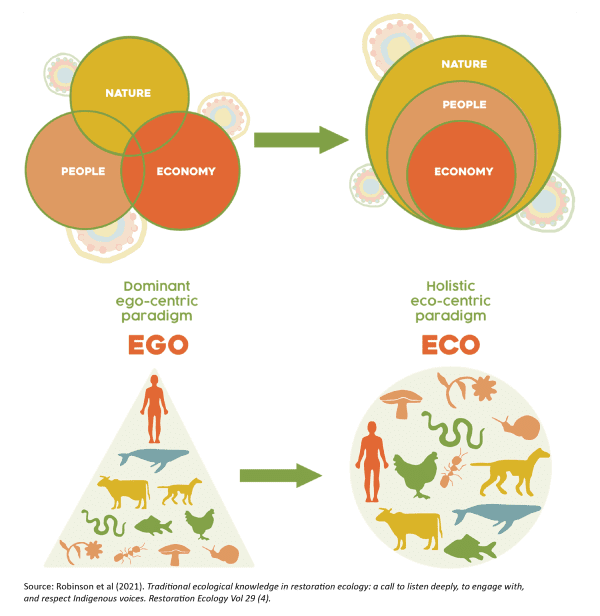It’s Biodiversity Month. So, what is Nature Positive?
A global aspiration. A galvanizing catchcry. A call to action for people everywhere. A single, consolidating term to unite environmentalists, ecologists and conservationists. Nature Positive is all of these things and so much more.

How did the term “Nature Positive” come about?
The term was launched after 188 countries (including Australia), endorsed the Global Biodiversity Framework[1] at the 2022 Conference of the Parties to the Convention on Biological Diversity (COP15) in Montreal, Canada. The framework commits countries to the 30x30x30 goal:
Protect 30% of land waters and seas, restore 30% of degraded ecosystem and complete both of these by the year 2030. The end goal is a reversal of nature loss by 2050.
To achieve this, the framework contains four long-term goals and 23 action-oriented global targets to enable achievement of the outcome-oriented goals for 2050. The framework was strongly influenced by a submission from a group of CEO’s from environmental organisations, sustainable business platforms and research institutes who argued for the adoption of a “…succinct Nature-Positive Global Goal for Nature…”[2]. And with that, Nature Positive was launched on a global scale as a global, outcome-oriented goal.

But what does “Nature Positive” really mean?
The term Nature Positive has been broadly adopted and embraced across governments, industries and conservationists because of its simplicity: stop nature loss, add more nature than what we have now.
This is where things have become a bit confused. Nature Positive is being used to describe all manner of initiatives and developments that simply incorporate an element of environmental planning, avoidance, mitigation or restoration. As a result, caution must be taken to avoid misuse of the term[3], particularly with increased attention on greenwashing from Australia’s corporate watchdog, the Australian Securities and Investments Commission (ASIC) and our competition regulator, the Australian Consumer and Competition Commission (ACCC)[4].
Nature positive is all of the following:
- A measurable, absolute improvement in the state of nature against a defined baseline
- Outcome-based – it is not a verb or a description of an action
- Measured against a 2020 baseline (or 2019 if the 2020 baseline isn’t appropriate for some reason)
- Ambitious and is going to be challenging to achieve
- Considers supply chain or value-chain impacts as well as business processes to reverse the decline of nature, not just consideration of direct actions
- A societal goal because it requires society to re-evaluate our values and belief systems and understand that we are wholly reliant on nature for our survival, our health and our wealth, and we are a part of nature, not separate to or above nature
- This is consistent with the ‘eco-centric’ instead of the ‘ego-centric’ view of the world
- This is in contrast to the concept of ‘sustainable development’ which has dominated the rhetoric around balancing economic, social and environmental priorities for the past few decades

Nature positive is not:
- Labelling avoidance, minimisation or mitigation measures as ‘nature positive’ because the result of implementation is a reduction in impacts to nature – the mitigation hierarchy is foundational to our current regulatory and legislative processes for approvals for projects or proposals that will impact on nature, implementation and adoption of the mitigation hierarchy (with emphasis on avoidance) is considered business as usual
- Compliance with regulatory obligations, including implementing offsets to compensate for nature impacts – nature positive goes beyond compliance
- Relying on generic credits (or financial payments) to compensate for value-chain impacts instead of like-for-like credits and without assessing the impact of value-chain actions and actively reducing these impacts
So, how do we achieve Nature Positive?
Nature Positive is complicated and challenging, but it is not impossible. Carefully considered actions supported by evidence reflecting systematic and deliberate assessment of impacts to nature and holistic, long-term initiatives to reduce impacts are needed and encouraged. Businesses and organisations can start by:
- Developing a Nature Strategy – this can be achieved by assessing material impacts, dependencies, risks and opportunities; developing goals and targets aligned with science-based targets for nature; and committing to changes to transform the nature and extent of their impacts on nature across the supply chain
- Consider nature-based solutions – when developing proposals, designs and projects, consider nature-based solutions as an alternative to hard-engineering or traditional solutions
Nature-based solutions deliver ecological, social and environmental co-benefits at the same time as providing solutions to standard project and development issues. These should be linked to a broader strategy and nature impacts should be avoided first, if this is considered to be part of your strategy to achieve a nature-positive outcome.
- Disclose your impacts – Did you know that as of 30 June 2024, there are 416 companies around the world that have signed up as early adopters of the Taskforce on Nature-Related Financial Disclosures? This includes companies like Coca-Cola and AstraZeneca as well as forestry, mining, renewable energy and agricultural companies
Public disclosure might seem like a big step with potentially adverse negative publicity implications. However, disclosure starts small and is iterative. It shows transparency and a willingness to improve, whilst advocating for change in your industry – all of which are important hallmarks of a move towards nature positive.
This starts with identifying your areas of influence, dependencies, impacts, risks and opportunities and has an additional benefit of improving an organisation’s visibility of one of the biggest risks facing company directors whilst aligning with corporate social responsibility objectives.
- Incorporate natural capital in your decision-making – Natural capital accounting can be a valuable inclusion to standard cost-benefit analyses that are used to inform decision-making. Considering the implications of decisions on ecosystem services and the flow-on benefits provided to communities, as well as the value of the natural capital asset, can provide a new dimension to decision-making whilst drawing out direct and indirect implications of changes and improving the comparability of economic, social and ecological factors
Are you seeking guidance on a Nature Positive approach for a project? Visit Umwelt’s Nature Positive page to find out more, or get in touch to discuss your specific needs.
[1] 15/4. Kunming-Montreal Global Biodiversity Framework. CONFERENCE OF THE PARTIES TO THE CONVENTION ON BIOLOGICAL DIVERSITY [Internet]. 2022 Dec 19; Available from: https://www.cbd.int/doc/decisions/cop-15/cop-15-dec-04-en.pdf
[2] Locke H, Rockström J, Bakker P, Bapna M, Gough M, Lambertini M, et al. A Nature-Positive World. Report submitted to COP15 [Internet]. 2020; Available from: https://www.nature.org/content/dam/tnc/nature/en/documents/NaturePositive
_GlobalGoalCEO.pdf#:~:text=The%20Global%20Goal%20for%20Nature%20identifies%20the%20level%20of%20ambition
[3] Maron M, Evans M, zu Ermgassen S. “Nature positive” isn’t just planting a few trees – it’s actually stopping the damage we do. The Conversation [Internet]. 2023 Sep 22; Available from: https://theconversation.com/nature-positive-isnt-just-planting-a-few-trees-its-actually-stopping-the-damage-we-do-213075
[4] McKenzie SA Baker McKenzie, Tanja Mikulic, Baker McKenzie, Anna Vella, Baker. The Fifth Estate. 2024 [cited 2024 Sep 4]. Greenwashing – millions of reasons to avoid it and be alert (but not alarmed). Available from: http://thefifthestate.com.au/columns/spinifex/greenwashing-millions-of-reasons-to-avoid-greenwashing-and-to-be-alert-but-not-alarmed/


